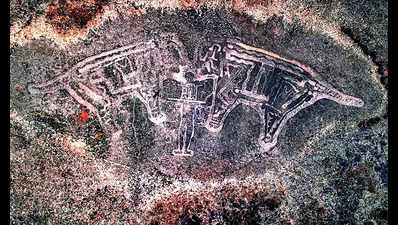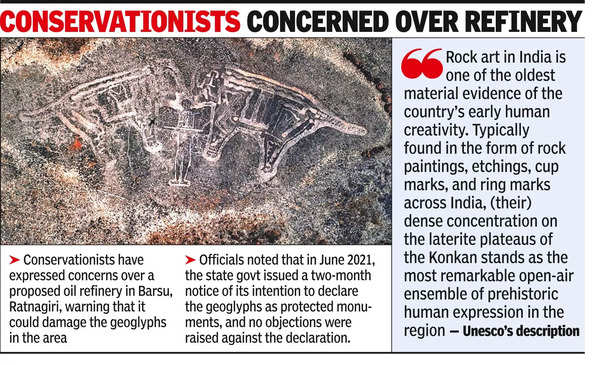[ad_1]

MUMBAI: In a serious transfer in the direction of conservation, the state govt has notified geoglyphs and petroglyphs in Ratnagiri as ‘protected monuments’ underneath the Maharashtra Historic Monuments and Archaeological Websites and Stays Act, 1960. The group of petroglyphs at Deud, Ratnagiri, dates again to the Mesolithic period (roughly 20,000-10,000 years in the past), in line with a notification by the tradition division.Geoglyphs and petroglyphs are various kinds of historical artwork kinds, each involving the creation of photos or designs on the earth’s floor or rock surfaces.
The petroglyphs depict a rhino, deer, monkey, donkey, and footprints, as per the notification. It stated that this group of petroglyphs within the Konkan holds extraordinary significance because it represents the creations of Mesolithic people; the full space across the monument to be protected is 210 sq metres. The newly protected petroglyphs are situated on land owned by Prasad Shankar Apte and others.

Anthropologists estimate the petroglyphs to be round 10,000 years previous. Whereas seven — one 17-ft lengthy — have been found in Umbarle village, Dapoli taluka, the eighth is in Borkhat village, Mandangad taluka. Clusters of geoglyphs, a type of prehistoric rock artwork carvings, are unfold alongside 900 km of the Konkan coast in Maharashtra and Goa. Though locals had recognized about a few of these as cultural relics left by their ancestors, their preliminary discovery was formally acknowledged in 2012. Ratnagiri alone is house to greater than 1,500 such artworks throughout 70 websites, seven of that are on the Unesco‘s tentative World Heritage checklist.
“Geoglyphs are a novel typology in human inventive artwork by way of dimension and scale. Proof of the most important span of time, Geoglyphs exist worldwide and are necessary cultural expressions since Paleolithic instances. Whereas most typical rock artwork in India are within the type of rock work, rock etchings, cup marks and ring marks, the big focus of geoglyphs on the laterite plateaus (Sada) within the Konkan are distinctive and most exceptional open-air ensembles of prehistoric human expression…
“These are distinct concentrations of pictorial representations that embody marine and riverine (life, in addition to mammals), reptiles, amphibian and avian life which vanished from the area centuries in the past,” the Unesco description of the Konkan petroglyphs states.
[ad_2]
This Put up might include copywrite


